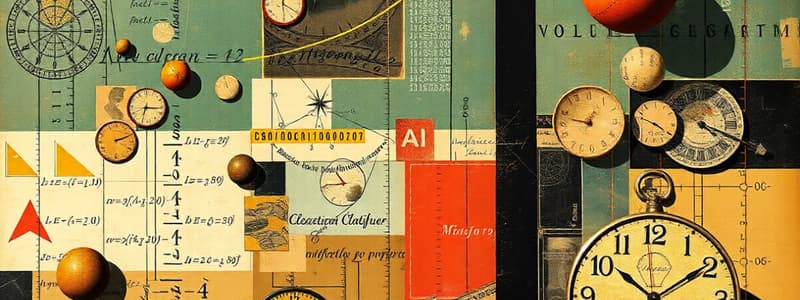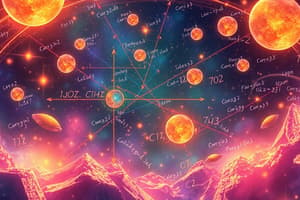Podcast
Questions and Answers
Flashcards
What is Mathematics?
What is Mathematics?
The abstract science of number, quantity, and space, studied in its own right (pure) or applied to other disciplines.
What is Arithmetic?
What is Arithmetic?
Deals with basic operations on numbers: addition, subtraction, multiplication, and division.
What is Algebra?
What is Algebra?
Uses symbols to represent numbers and quantities, manipulating these symbols to solve equations.
What is Geometry?
What is Geometry?
Signup and view all the flashcards
What is Calculus?
What is Calculus?
Signup and view all the flashcards
What are Rational Numbers?
What are Rational Numbers?
Signup and view all the flashcards
What are Equations?
What are Equations?
Signup and view all the flashcards
What are Graphs?
What are Graphs?
Signup and view all the flashcards
What are Functions?
What are Functions?
Signup and view all the flashcards
What are Sets?
What are Sets?
Signup and view all the flashcards
Study Notes
- Mathematics is the abstract science of number, quantity, and space
- It can be studied in its own right (pure mathematics) or as it is applied to other disciplines such as physics and engineering (applied mathematics)
- Mathematical study helps to develop analytical and problem-solving skills
Core Areas of Mathematics
- Arithmetic involves basic operations on numbers like addition, subtraction, multiplication, and division
- Algebra deals with symbols and the rules for manipulating these symbols
- Geometry studies shapes, sizes, and positions of figures
- Calculus concerns continuous change and rates of change
Arithmetic
- Focuses on number systems and operations
- Integers are whole numbers, positive, negative, or zero
- Rational numbers can be expressed as a fraction of two integers
- Real numbers include both rational and irrational numbers
- Complex numbers include a real and imaginary part
- The basic operations are addition, subtraction, multiplication, and division
- Order of operations is crucial (PEMDAS/BODMAS)
- Percentages, ratios, and proportions are key concepts
Algebra
- Uses symbols to represent numbers and quantities
- Variables are symbols representing unknown values
- Expressions are combinations of variables and constants
- Equations show the equality between two expressions
- Solving equations involves finding the values of variables that make the equation true
- Linear equations involve variables to the first power and graph as a straight line
- Quadratic equations involve variables to the second power
- Polynomials are expressions with multiple terms involving variables raised to non-negative integer powers
- Functions describe relationships between variables
Geometry
- Concerns the properties and relations of points, lines, surfaces, solids, and higher dimensional analogs
- Euclidean geometry is based on postulates by Euclid
- Key concepts include points, lines, angles, planes, and solids
- Shapes include triangles, quadrilaterals, circles, and polygons
- Theorems describe relationships between geometric figures
- Pythagorean theorem relates the sides of a right triangle
- Trigonometry studies relationships between angles and sides of triangles
- Analytic geometry uses algebra to describe geometric objects
- Coordinate systems are used to locate points in space
Calculus
- Deals with continuous change
- Differential calculus concerns rates of change and slopes of curves
- Integral calculus concerns accumulation of quantities and areas under curves
- Limits are foundational to calculus, describing values functions approach
- Derivatives measure the instantaneous rate of change of a function
- Integrals measure the area under a curve
- Fundamental theorem of calculus connects differentiation and integration
- Applications include optimization, related rates, and motion problems
Mathematical Reasoning and Proof
- Mathematics relies on logical reasoning
- Proofs establish the truth of mathematical statements
- Direct proofs start with assumptions and use logical steps to reach a conclusion
- Indirect proofs, such as proof by contradiction, assume the opposite of what is to be proven
- Mathematical induction proves statements for all natural numbers
- Counterexamples disprove universal statements
- Theorems are proven mathematical statements
- Axioms are statements assumed to be true without proof
- Logic is the foundation for mathematical reasoning using concepts such as implication, negation, conjunction, disjunction and quantifiers
Mathematical Problem Solving
- Understanding the problem is the first step
- Devise a plan to solve the problem
- Carry out the plan
- Look back and check the solution and method
- Strategies include drawing diagrams, looking for patterns, using formulas, and working backwards
- Key skills include critical thinking, logical reasoning, and attention to detail
Mathematical Modeling
- Mathematical models represent real-world situations using mathematical concepts
- The process involves identifying variables, formulating equations, solving the equations, and interpreting the results
- Models can be used to make predictions and understand complex systems
- Examples include population growth models or physics simulations
Discrete Mathematics
- Deals with discrete objects and structures
- Logic is the foundation of discrete mathematics
- Set theory studies collections of objects
- Relations and functions define relationships between sets
- Graph theory studies networks
- Combinatorics deals with counting and arrangements
- Probability theory deals with the likelihood of events
Statistics and Probability
- Statistics involves collecting, analyzing, and interpreting data
- Descriptive statistics summarize and present data
- Inferential statistics draw conclusions from data
- Probability theory studies randomness and uncertainty
- Probability distributions describe the likelihood of different outcomes
- Statistical tests are used to test hypotheses
- Regression analysis models relationships between variables
Numerical Analysis
- Numerical analysis develops algorithms for solving mathematical problems on computers
- It involves approximation and error analysis
- Root finding algorithms find solutions to equations
- Numerical integration approximates definite integrals
- Numerical linear algebra solves systems of linear equations
- Applications include scientific computing and engineering simulations
Advanced Topics
- Real Analysis rigorously studies real numbers, sequences, series, and functions
- Complex Analysis extends calculus to complex numbers
- Abstract Algebra studies algebraic structures such as groups, rings, and fields
- Topology studies properties of spaces that are preserved under continuous deformations
- Differential Equations model relationships between functions and their derivatives
- Partial Differential Equations involve functions of multiple variables and their partial derivatives
- Number Theory studies properties of integers
Importance of Mathematics
- Essential for science, technology, engineering, and finance
- Develops critical thinking and problem-solving skills
- Provides a foundation for understanding the world around us
- Used in computer science, data analysis, economics, and many other fields
- Fosters logical reasoning and analytical abilities
Key Mathematical Concepts
- Numbers and operations
- Variables and expressions
- Equations and inequalities
- Functions and graphs
- Geometric shapes and their properties
- Rates of change and accumulation
- Probability and statistics
Sets
- A set is a well-defined collection of distinct objects, considered as an object in its own right
- Sets are typically denoted by uppercase letters
- Elements of a set are denoted by lowercase letters
- The empty set is the set containing no elements
- The universal set contains all possible elements
- Operations on sets are union, intersection, difference, and complement
Functions
- A function is a relation between a set of inputs and a set of permissible outputs with the property that each input is related to exactly one output
- The input set is called the domain and the output set is called the range
- Functions can be represented by equations, graphs, or tables
- Common types of functions include linear, quadratic, exponential, and trigonometric functions
- Transformations of functions include translations, reflections, and stretches
Graphs
- A graph is a visual representation of data or relationships
- Graphs can be used to represent functions, equations, or statistical data
- Common types of graphs include bar graphs, line graphs, pie charts, and scatter plots
- The coordinate plane is used to graph functions and equations
- The x-axis is the horizontal axis and the y-axis is the vertical axis
- The point where the axes intersect is called the origin
Logic
- Logic is the study of reasoning
- Statements are declarative sentences that are either true or false
- Logical connectives are used to combine statements
- Common logical connectives include and, or, not, if...then, and if and only if
- Truth tables are used to determine the truth value of compound statements
- Quantifiers are used to make statements about all or some elements in a set
Studying That Suits You
Use AI to generate personalized quizzes and flashcards to suit your learning preferences.




